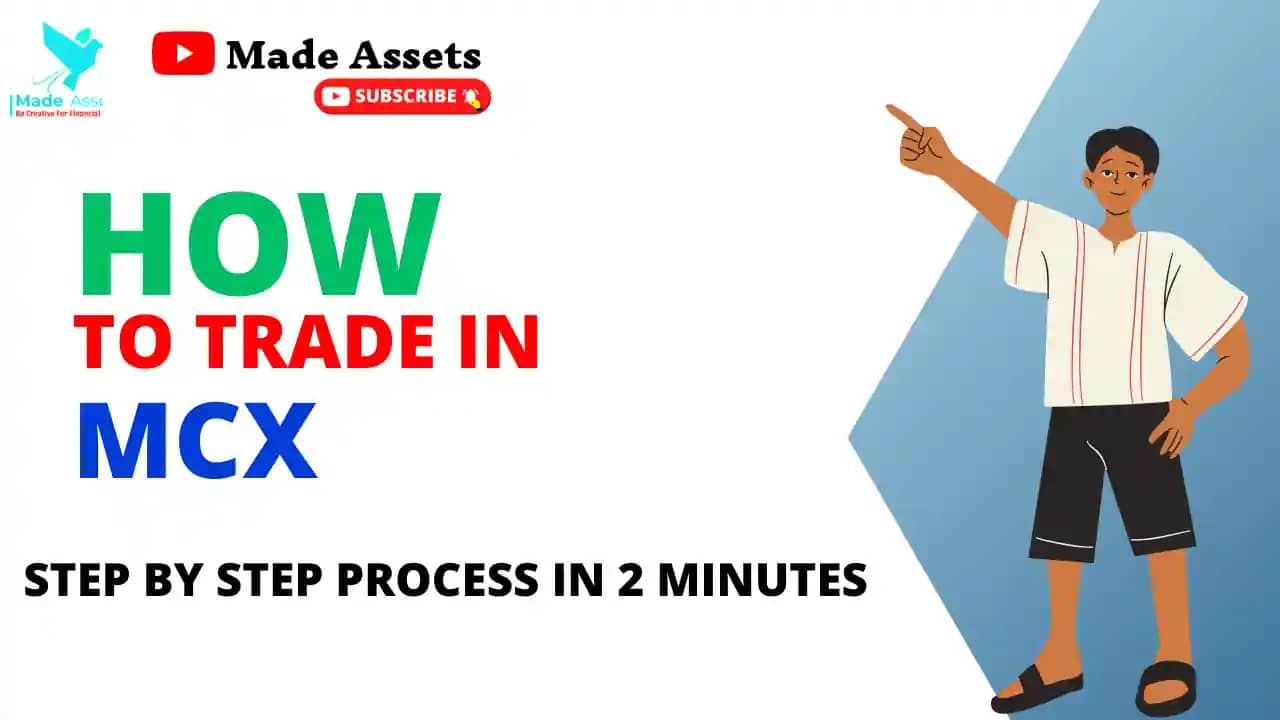How to Trade in MCX: Trading in MCX (Multi Commodity Exchange) offers individuals the opportunity to participate in the dynamic world of commodity markets. Whether you’re interested in trading gold, silver, crude oil, or other commodities, understanding the basics of MCX trading is essential. In this article, we will guide you through the process of how to trade in MCX, providing valuable insights and tips to help you navigate this exciting marketplace.
Understanding MCX: An Overview
MCX is India’s largest commodity derivatives exchange, providing a platform for trading in various commodities, including precious metals, energy products, base metals, and agricultural commodities.
It offers a transparent and regulated marketplace where buyers and sellers can trade futures contracts based on different commodities.
Setting Up a Trading Account
To start trading in MCX, you need to open a trading account with a registered MCX broker. Choose a reputable broker that provides a user-friendly trading platform, competitive brokerage fees, and reliable customer support.
Complete the account opening process by submitting the required documents and fulfilling any financial requirements.
Conducting Fundamental Analysis
Before placing trades in MCX, it’s crucial to conduct a fundamental analysis. This involves studying the factors that influence the supply and demand dynamics of the commodity you wish to trade. Factors such as geopolitical events, weather conditions, economic indicators, and government policies can impact commodity prices.

Analyzing Technical Indicators
In addition to fundamental analysis, technical analysis plays a significant role in MCX trading. Technical indicators help identify trends, support, and resistance levels, and potential entry and exit points.
Traders use tools like charts, moving averages, oscillators, and trend lines to analyze price patterns and make informed trading decisions.
Placing Orders in MCX
Once you have performed your analysis and identified a potential trading opportunity, it’s time to place an order in MCX.
The trading platform provided by your broker will allow you to enter the relevant details, such as the commodity, contract expiry, order type (market or limit), quantity, and price. Review the order carefully before submitting it.
Managing Risk in MCX Trading
Risk management is a crucial aspect of successful MCX trading. Set a predetermined stop loss level to limit potential losses in case the trade goes against you. Determine the risk-reward ratio for each trade, ensuring that potential profits outweigh potential losses.
Additionally, consider diversifying your trades across different commodities to reduce exposure to any single commodity’s price fluctuations.
Related Articles: Why Options Trading Is So Dangerous?
Developing a Trading Strategy
Having a well-defined trading strategy is essential for consistent success in MCX trading. Your trading strategy should outline your trading goals, risk tolerance, preferred commodities, and the indicators and tools you will use for analysis. Regularly evaluate and refine your strategy based on your trading performance and market conditions.
Using Stop Loss and Take Profit Orders
To protect your trades and optimize profits, it is important to use stop loss and take profit orders effectively. A stop loss order is placed to automatically close a position if the market moves against you, limiting potential losses.
On the other hand, a take-profit order is used to secure profits by automatically closing a position when the market reaches a predetermined level of profit.
When setting stop loss and take profit levels, consider the volatility of the commodity you are trading, as well as your risk tolerance. Avoid setting levels that are too tight, as it may result in premature exits due to minor price fluctuations. Conversely, setting levels too wide may expose you to excessive risk. Regularly review and adjust your stop loss and take profit levels as the market conditions evolve.
Monitoring Trades and Market News
Once your trades are executed, it is essential to monitor them actively. Keep a close eye on price movements, news events, and any other factors that can impact the commodity market.
Stay updated with relevant market news and economic indicators that can influence commodity prices. This information will help you make informed decisions about managing your open positions.
Additionally, consider using price alerts and notifications provided by your trading platform. These alerts can notify you when prices reach certain levels or when specific market conditions are met. By staying vigilant and informed, you can take prompt actions to adjust your trades if necessary.
Evaluating Performance and Making Adjustments
Regularly assessing your trading performance is crucial for continuous improvement. Keep a record of your trades, including entry and exit points, profit and loss levels, and the rationale behind each trade. Analyze your trading results periodically to identify patterns and areas for improvement.
If you notice consistent mistakes or losses, evaluate your trading strategy and make necessary adjustments. This could involve refining your analysis techniques, modifying risk management parameters, or seeking additional education or guidance. Successful trading requires a willingness to adapt and learn from your experiences.
Common Mistakes to Avoid in MCX Trading
While trading in MCX, it is important to be aware of common mistakes that can hinder your success. Avoid the following pitfalls:
- Lack of proper risk management: Failing to set stop loss orders or disregarding risk-reward ratios can expose you to significant losses.
- Emotional trading: Allowing emotions, such as fear or greed, to dictate your trading decisions can lead to impulsive and irrational actions.
- Overtrading: Excessive trading without a solid strategy or analysis can result in unnecessary losses and increased transaction costs.
- Chasing the market: Trying to enter trades at the peak or bottom of a price movement can be risky. Focus on identifying trends and trading with the flow.
- Neglecting research and analysis: Insufficient research and analysis can lead to poor trade decisions based on incomplete information.
By being aware of these common mistakes and actively avoiding them, you can enhance your trading performance and minimize potential losses.
Resources and Further Learning
To deepen your understanding of MCX trading, take advantage of the various educational resources available. Some valuable resources include:
- Online courses and webinars: Many trading platforms and educational websites offer courses and webinars specifically tailored to MCX trading.
- Books and e-books: Explore books written by experienced traders and experts in commodity trading to gain insights and learn effective strategies.
- Forums and communities: Engage with fellow traders in online forums and communities to exchange ideas, ask questions, and learn from shared experiences.
- Demo accounts: Practice trading using virtual money on demo accounts provided by brokers. This allows you to gain hands-on experience without risking real capital.
Continuous learning and self-improvement are key to evolving as a successful MCX trader.
How to Trade in MCX Conclusion
Trading in MCX can be a rewarding venture for those interested in the world of commodity markets. By following the steps outlined in this guide, you can embark on your MCX trading journey with confidence and a solid foundation.
Remember to start by understanding the basics of MCX and setting up a trading account with a reputable broker. Conduct thorough fundamental and technical analysis to identify potential trading opportunities. Use stop loss and take profit orders to manage your trades effectively and protect your capital. Stay informed about market news and constantly evaluate and adjust your trading strategy.
It is important to be aware of common mistakes and pitfalls in MCX trading, such as poor risk management and emotional trading. By avoiding these mistakes and continuously learning from your experiences, you can improve your trading performance over time.
In conclusion, MCX trading offers ample opportunities for individuals to participate in the dynamic commodity markets. With proper knowledge, strategy, and discipline, you can navigate this exciting realm and potentially achieve your financial goals.
Frequently Asked Questions
Q.1 Is MCX trading suitable for beginners?
A.1 Yes, MCX trading can be suitable for beginners. However, it is important to educate yourself about the market, develop a trading plan, and start with a small amount of capital that you can afford to risk.
Q.2 How much capital do I need to start trading in MCX?
A.2 The amount of capital required to start trading in MCX varies depending on your trading strategy and risk tolerance. It is advisable to start with a capital that you are comfortable with and can afford to lose.
Q.3 Can I trade in multiple commodities simultaneously?
A.3 Yes, you can trade in multiple commodities simultaneously. Diversifying your trades across different commodities can help spread the risk and potentially enhance your trading opportunities.
Q.4 What is the role of technical analysis in MCX trading?
A.4 Technical analysis helps traders identify trends, support and resistance levels, and potential entry and exit points. It uses historical price data and various indicators to predict future price movements.
Q.5 How can I manage risk in MCX trading?
A.5 Risk management is crucial in MCX trading. Set stop loss levels to limit potential losses and determine a risk-reward ratio for each trade. Diversifying your trades and regularly evaluating your trading strategy are also effective risk management techniques.


Best best best..